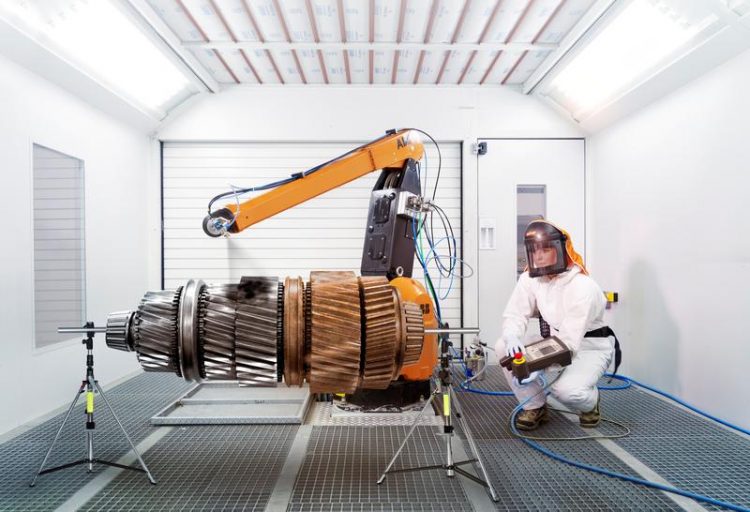Hannover Messe: New low friction coating allows grease-free lubrication and corrosion protection

Grease-free lubrication and corrosion protection at once via spray coating. Copyright: Uwe Bellhäuser, only free within this press release.
They attract dirt, debris and dust, and over time form lumps or become resinous. Machine parts then have to be intensively cleaned and regreased, which leads to more frequent maintenance, greater consumption of resources, polluting waste or machine breakdowns.
Researchers at the INM – Leibniz Institute for New Materials have now developed a functional coating which lubricates without grease and protects against corrosion at the same time. It is suitable as a coating for metals and metal alloys such as steel, aluminum or magnesium.
From 7 to 11 April 2014, the researchers of the INM will be presenting this and further results in Hall 2 at the stand C48 of the Hannover Messe in the context of the leading trade fair for R & D and Technology Transfer. This includes new developments of transparent and conducting layers, CIGS solar cells, antimicrobial coatings and corrosion protection coatings as well as printed electronics.
“The thing about our low friction coating is its composition and structure”, explains Carsten Becker-Willinger, Head of the Nanomers Program Division. “We have incorporated platelet-like solid lubricants and platelet-like particles in a binder. When this mixture is applied to a surface, it produces a well-ordered structure in which these various particles are arranged in a roof tile pattern”, he adds. This forms a so-called transfer film between the low friction coating and the object through which surfaces can slide with the minimum of friction.
“The particular mixture ratio means that our composite has a very low coefficient of friction. If we only used a solid lubricant, the coefficient of friction would be considerably higher”, says the chemist.
The roof tile structure not only provides low-friction sliding, it also acts as a barrier. This is a particular advantage because as a result the material also prevents moisture or salts penetrating metal surfaces, thus also protecting against corrosion. In a neutral salt spray context, the composite has a corrosion resistance of over 1000 hours on low-alloy steel.
The bonded coating can be applied using classic wet chemistry processes such as spraying or dipping. The roof tile structure forms by simple thermal curing without any further assistance in self-organization.
Contact:
Dr. Carsten Becker-Willinger
INM – Leibniz Institute for New Materials
Head Nanomers
Phone: +49681-9300-196
nanomere@inm-gmbh.de
Your contact at the stand:
Dr. Sabine Schmitz-Stöwe
Dr. Dirk Bentz
The INM will also present its competence within various talks in Hall 2 at the Tech transfer stand.
* „Nanotechnology at the INM – Leibniz Institute for New Materials“, Dr. Mario Quilitz, Monday, 7.4. 2014, 10:15 – 10:30 a.m.
* „Nanotechnology in the Leibniz Network Nano“, Dr. Mario Quilitz, Monday, 7.4.2014, 12:00 – 12:15 p.m.
* „Nanoparticles for Optics and Electronics“, Dr. Peter William de Oliveira, Tuesday, 8.4.2014, 11:00 – 11:10 a.m.
* „Nanomers – Highly structured integrated functional coatings for practical solutions in industrial applications“, Dr. Carsten Becker-Willinger, Tuesday, 8.4.2014, 11:20 – 11:35 a.m.
INM conducts research and development to create new materials – for today, tomorrow and beyond. Chemists, physicists, biologists, materials scientists and engineers team up to focus on these essential questions: Which material properties are new, how can they be investigated and how can they be tailored for industrial applications in the future? Four research thrusts determine the current developments at INM: New materials for energy application, new concepts for medical surfaces, new surface materials for tribological applications and nano safety and nano bio. Research at INM is performed in three fields: Nanocomposite Technology, Interface Materials, and Bio Interfaces.
INM – Leibniz Institute for New Materials, situated in Saarbruecken, is an internationally leading centre for materials research. It is an institute of the Leibniz Association and has about 195 employees.
Media Contact
All latest news from the category: HANNOVER MESSE
Newest articles

First-of-its-kind study uses remote sensing to monitor plastic debris in rivers and lakes
Remote sensing creates a cost-effective solution to monitoring plastic pollution. A first-of-its-kind study from researchers at the University of Minnesota Twin Cities shows how remote sensing can help monitor and…

Laser-based artificial neuron mimics nerve cell functions at lightning speed
With a processing speed a billion times faster than nature, chip-based laser neuron could help advance AI tasks such as pattern recognition and sequence prediction. Researchers have developed a laser-based…

Optimising the processing of plastic waste
Just one look in the yellow bin reveals a colourful jumble of different types of plastic. However, the purer and more uniform plastic waste is, the easier it is to…



